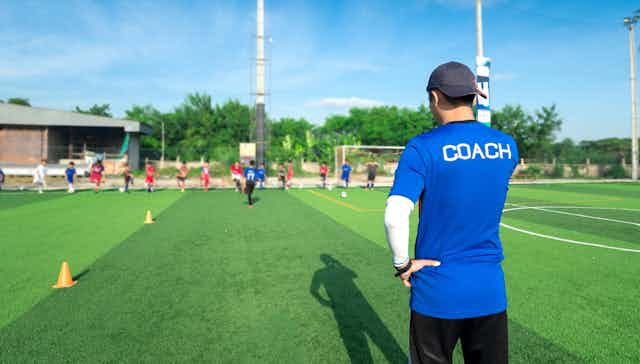Sports coaches are often under pressure to maximise the performance of their athletes and teams. With good intentions, they often turn to the latest hyped psychological techniques and ideas – many of which are not well supported by scientific evidence.
The following five techniques are widely used by sports coaches. None have robust evidence to back them up.
1. Learning styles
Learning styles assumes that people have an innate preference for how they are coached, and it influences their learning. For example, the theory claims that some people will learn best by watching a skill or technique (visual learning), others by listening to the description of a particular skill (auditory learning), and some by practising the movement or skill (kinaesthetic learning).
According to this theory, one athlete might best learn how to serve in tennis by watching a coach hit a serve, while others might best learn by listening to a description of how to hit a serve. Others still may best learn by practising the actions.
This is a widely held belief, often promoted by sport governing bodies. My recent study found that most coaches believe that athletes have their own preferred learning style.
However, there is no evidence that learning is improved via visual, auditory or kinaesthetic coaching styles, compared with instruction that does not focus on the senses.
2. Neuro-linguistic programming
Neuro-linguistic programming (NLP) practitioners claim that eye movements reveal thoughts. For example, if a person is looking up to the left or to the right, he or she is trying to visualise something, such as a new skill, but if a person looks down to the right, he or she is thinking about feelings.
Coaches, it is argued, could use this information to identify what an athlete is thinking about and so help to change those thoughts. If an athlete is thinking about his or her feelings immediately before a competition starts – as revealed by eye movements – this could compromise their performance. As such, the coach could ask the athlete to focus on tactics or specific thoughts related to the upcoming competition and then monitor the athlete’s eye movement to see if it has been successful.
NLP claims that the behaviour and thoughts of elite athletes can be modelled to help other athletes improve. Coaches then use this model to help their own athletes.
For example, if the best golfers reveal that they focus on the target and flight of the ball when preparing for a shot in golf, coaches might use NLP to teach their golfers to up their game by doing likewise.
NLP advocates offer many anecdotes about how it has transformed the performance or lives of individuals, but there is no convincing empirical evidence to support these claims.
3. Brain Gym
Brain Gym comprises a series of simple movements, such as touching your left heel with your right hand and then your right heel with your left hand, or placing a thumb and index finger either side of the chest bone, while your other hand rubs your stomach. The aim of these movements is to improve coordination and make movements more efficient.
Advocates for this method also claim that performing these movements increases motivation, concentration and focus.
All of these outcomes could, potentially, benefit athletes. But the evidence for these claims is questionable.
4. Myers-Briggs type indicator
Many sports organisations use Myers-Briggs, a questionnaire that assesses personality type, to decide whether to recruit an athlete for their team or programme.
Coaches also use Myers-Briggs to help them understand how their players behave and make decisions, so they can communicate more effectively with their athletes or players.

Although the technique is popular, some experts have voiced concerns about it. The most significant problem is that it classifies people into broad categories, such as introvert or extrovert. But this approach is too simplistic and does not fully capture the complexity of personality.
Since personality remains relatively stable throughout a person’s life, a person’s “indicator” should be the same if the questionnaire is completed by the same person a week, a month or six months later. Yet studies show that Myers-Briggs indicators change, which raises questions about whether it reliably assesses personality.
5. ActionTypes
ActionTypes is a combination of learning styles, practices to boost the brain and movement styles that are similar to Brain Gym.
This method boasts high-profile advocates, including elite sports coaches who say it helps them to understand their players better and enables players to understand their own bodies better. But since information about this approach is hard to come by, and there have been no published studies, we have to conclude that ActionTypes is not a credible method for coaches.
Coaches should rely on the best available evidence-based ideas and practices to inform their work, but my latest research shows that this isn’t always the case.
Many coaches use unscientific methods (such as those listed above), and many of these questionable methods are delivered during coach-education programmes, which are created by national sport governing bodies. This is a worrying trend that could have a negative impact on the performance of current and future sporting stars.

